Note: Toys by Troy shut down their operation at the end of 2007. Instead of removing this write-up, I am leaving it on the web site for a couple of reasons. The steps for installing it are pretty much the same as one from another manufacturer and so you’ll get an idea of what is involved if you decide to do this type of modification. If you happen to come across one on the used market, you’ll have some information about it that can help you do the installation correctly.
Note: This write-up started with pics and comments from July, 2003, when TBT installed the lift. In February, 2005, I decided to update/refresh the information contained in the write-up…..so don’t get too confused if the you feel as though you are in a time machine, flip-flopping back and forth between now and then. As I update the write-up, I’ve had my lift on the TJ now for more than 18 months. I just recently had the opportunity to help install this lift (the production version I should say) and the Alumi-flex steering on my buddy’s TJ (Robert Yates). While I missed the experience gained from doing the installation on my TJ, I believe the knowledge acquired from helping with Robert’s install can add something to this write-up. With all that being said, let’s get on to the lift installation.
Well, I’ve sat on this project long enough so I thought I would share some of the “work in progress” pictures with you.
The pics below were taken today, July 14th, 2003, at the Toys by Troy fab shop (shortly before the company moved into their new facility). You won’t find this Alumi-flex long arm lift on his web site, at least not yet. This is about the 12th one he has done. He hopes to have this available in kit form by the end of this year. At this point in time, some of the components are being hand built and as such, Troy considers that to be custom work. Once he can program the laser machine to cut the pieces to spec, he will consider it ready to be delivered in kit form.
I don’t have all of the details on the lift yet. Things are bound to change as time goes one and refinements are made. I am already benefiting from a couple of tweaks that were made based on those that came before me. So, don’t be too disappointed if I don’t have all the answers right now. I’ll get them as time goes on and I have a chance to check things out and talk more with Troy. You also have to understand that aside from some differential work, this is pretty much the first time I turned my TJ over to someone to do work that I have done myself in the past. However, I don’t have the tools nor the fab skills to pull this off so I leave it to Troy and his crew. Many thanks goes to Troy and Gordon, who has installed many (all?) of the existing Alumi-flex lifts thus far. Gordon didn’t mind me poking my nose into his work area this afternoon so I could snap these pictures.

We ended up installing 8″ Skyjacker springs during this makeover. At the same time, the factory transfer skid was discarded and an RE skid was put in its place (TBT now manufactures their own skid for this lift). With the transfer case moving up (from the tighter fitting RE skid) and the frame moving up (from the taller springs), my existing rear CV drive shaft was too short.
Luckily, I had won a $200 gift certificate from Tom Wood during the 3rd Annual JeepsUnlimited Moab Run earlier in the year. This covered about two-thirds of the new drive shaft I needed. The three year old RE “hack and tap” SYE was removed and a new AA SYE was installed. Although I had purchased the RE SYE used, it was still working just fine when it was removed from my t-case and went into the collection of parts that would be sold to help offset the cost of this project.
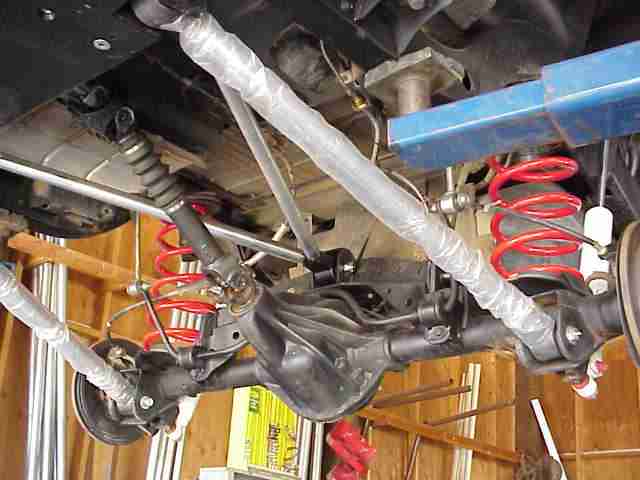
Don’t ask me….I guess they are long arm condoms. Pretty good idea! Actually, the plastic packing sleeves are left in place while the lift is installed. Yeah, the arms will get scraped out on the trail but at least I will get the pleasure of putting the first ones on them myself. In the above pic, I still have the RE extended sway bar links installed (from the previous RE/PC lift). These were later removed and replaced by my original Currie Antirock front links. They were about 2″ longer than the RE links, which was right at the length I needed.
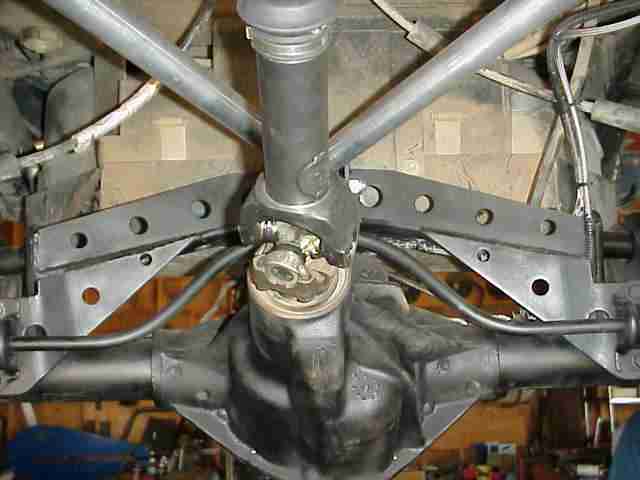
Here is a view of what use to be the upper control arm mounts. The upper control arm mounts and three bolts on the rear diff cover help secure the triangulated rear link mounting location (more on that below). The rear track bar is history (add it to the pile of parts to sell) along with the angled track bar relocation bracket that was used with the RE adjustable track bar. The new alumi-flex upper arms are tapped for both left and right hand threads. To set your pinion angle for your CV drive shaft, just loosen the jam nuts on the upper arms and adjust both sides the same amount.
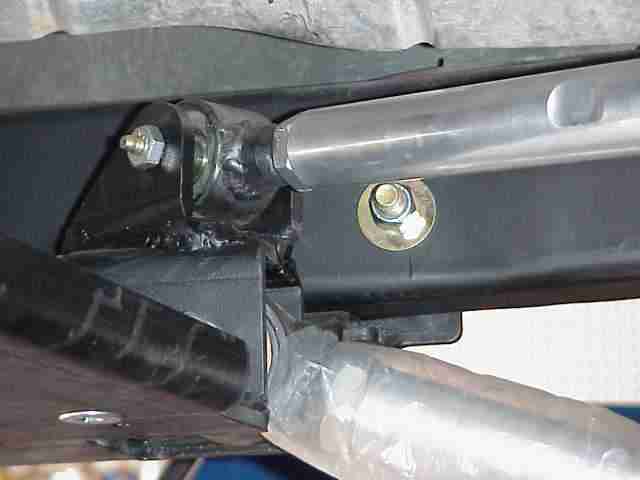
This was the original mounting configuration for my rear upper/lower control arms at the center skid. The upper control arm cartridge joint (smaller than the lower joint) was later replaced with a poly bushing (same size as the catridge joint) in the production lift. It handles the side load better than the small cartridge joint and does not affect the flex of the rear axle.

Another view of the upper link mounting bracket. In addition to the upper control arm brackets and diff cover bolts, the sway bar mounting brackets are also employed as part of the mount’s attachment points.
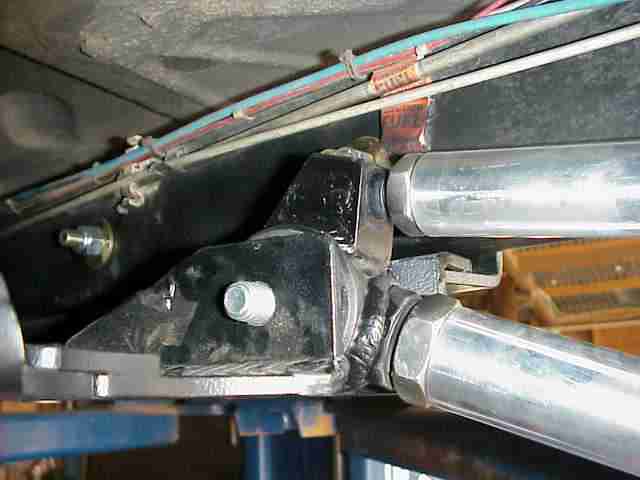
Here is the front upper and lower control arm mounting point on the skid plate. There is no bushing or joint used at this end of the upper arm. The axle end of the upper arm uses the factory rubber bushing that is installed at the axle’s upper arm brackets.
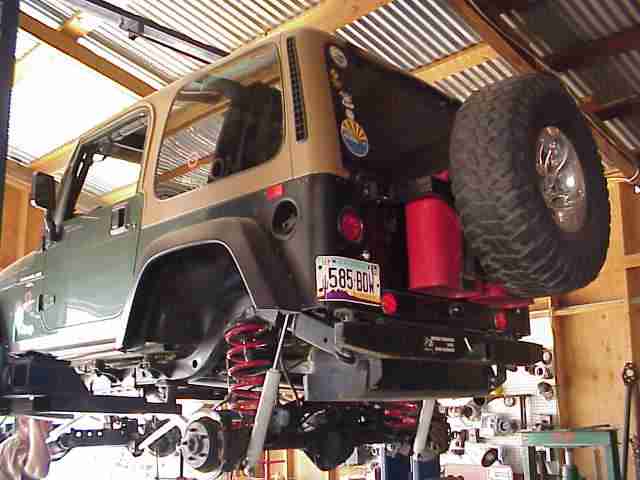
Nothing special here….just the TJ sitting up on the lift. The rear axle is currently at max droop. The shocks are probably the limiting factor right now, although the rear sway bar links are almost vertical too. I’ve not checked the rear drive shaft for u-joint bind although a quick look this afternoon suggested this was not an issue.
The TBT lift comes with Rancho RS-9000 adjustable shocks, front and rear. I opted to save a couple of dollars here since I had recently installed longer shocks during my rear shock relocation project. I realize that my rear shocks are a little shorter than optimum, but I still have plenty of droop. The next time the shocks are replaced, I’ll get a longer model and then go worry about the sway bar links again. DOH!
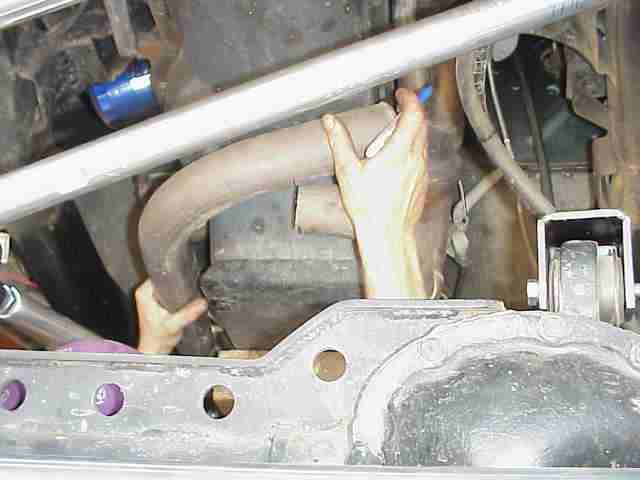
Gordon marks the exhaust for some more modifications. TBT also includes a new muffler, catalytic converter, and exhaust pipe with the lift. The factory exhaust it cut at the front of the oil pan and discarded. All new components and pipe are installed from that point to the rear bumper. The factory O2 sensors and wiring are re-used on the new exhaust.
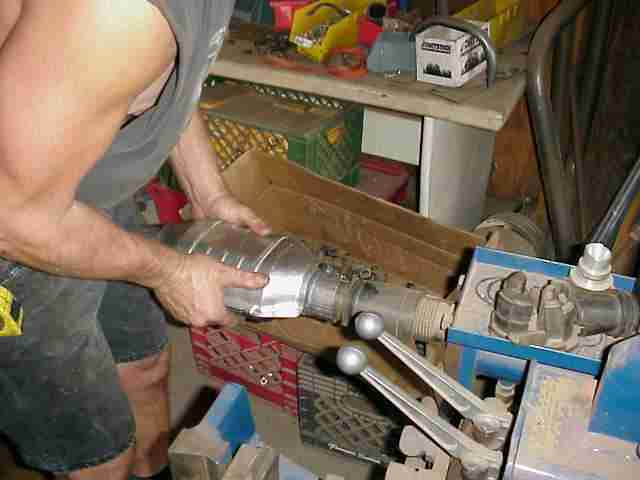
The new catalytic converter gets its inlet (or was that the outlet) resized on a real spiffy machine. While most folks moan and groan over exhaust modifications that always accompany a long arm lift, I have to admit it was quite painless. TBT has a tubing bender just for exhaust work. Mike, one of TBT’s employees that has dimensioned the current exhaust system, has shared some hints and tips on using the machine. I found that it is not as easy as it may first appear…..but if you can spacially 3-D model what the piping looks like in your head, it is a piece of cake! <grin>
TBT Alumi-flex Lift
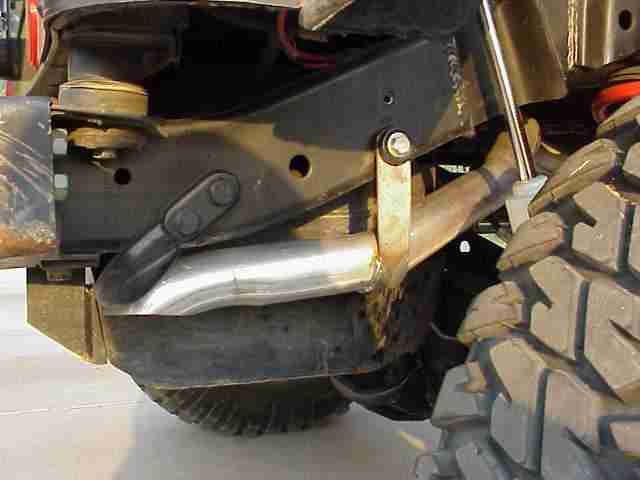
The exhaust exits the vehicle at the same point as the factory system. The tip is tucked up as close as possible to help avoid getting it into the rocks.
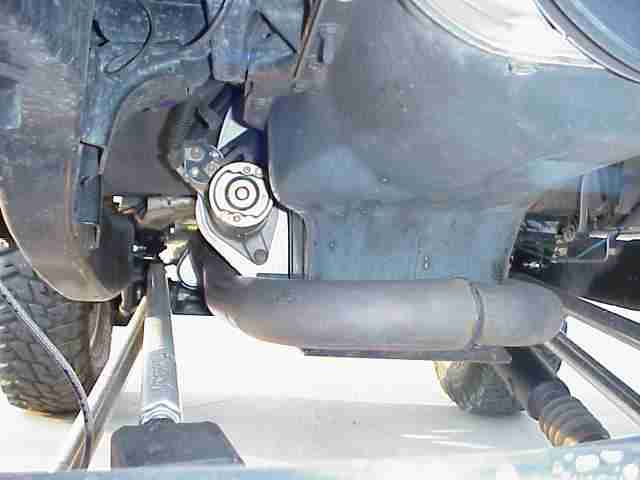
After welding the exhaust near the oil pan, you can just see route taken as it goes up and over the skid. The cat and muffler is mounted on an angle as the available space, now partially taken up by the rear long arm mounts, makes for a snug fit.
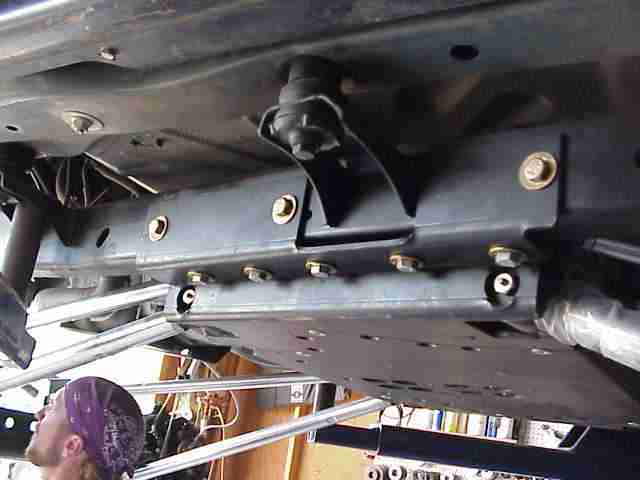
My lift was installed using an RE skid plate. As was mentioned earlier, TBT now manufactures their own skid. Even though I was previously running a 6″ lift, the factory skid always seemed to be in the way. Having this one tucked up tighter to the frame makes it a bit easier to get over those ledges without high centering the rig on the belly plate.
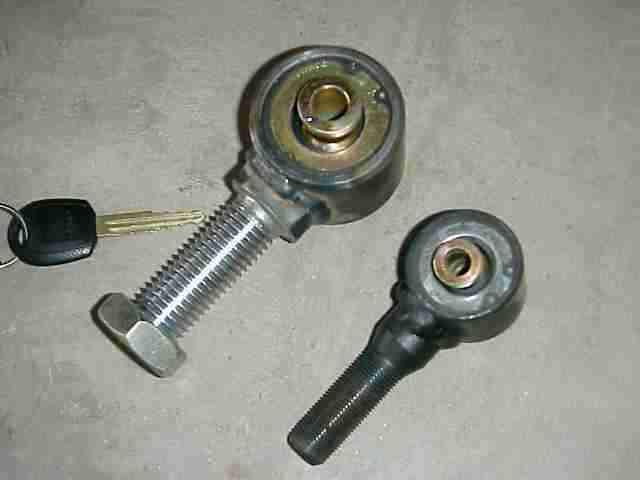
A pic of the cartridge joints that were installed in my rig. The large joints are used on the lower arms while the small one was used on the upper rear arms. It has since been replaced by a bushing joint.
The previous information is but a spattering of what went into putting the lift on. When we did Robert’s TJ (which included the alumi-flex steering), we put in about 50 man hours (squeezed into a Thursday and Friday) before we called it near done.
TBT Alumi-flex Lift
I got a chance to burn a trail this Saturday morning with a couple of local Jeepers. We met up, bought some coffee at the convenience store, and headed off to the trail at 6:00 AM (wanted to beat the summer Phoenix heat). A 15 minute drive down the freeway brought us to the turn off and unofficial air down spot. 10 minutes later, we were heading down the access trail and working our way back to Upper Tax Collector (also known as Firebird). I chose this trail because it is fairly short (we wanted to be done by mid-morning) and we have used it for similar shake down runs. Basically, it was an uneventful trip. No parts fell off, I didn’t get stuck, the long arm lift exceeded my expectations (I really liked it on the rough access road), my lockers worked fine, the steering did everything it should have done, I didn’t detect any rear steer (one obstacle on this trail has really emphasizes it on many vehicles), I drug the new belly pan across some rocks (it is no longer a virgin), the alumi-flex arms never touched a rock (did I mention they are magic?), I can unseat the front coils during droop, no death wobble at freeway speeds (not even a hint of it), and the new rear diff guard did its job. So, like I said, it was an uneventful run….BUT IT SURE WAS FUN! I picked some of the biggest rocks in the wash to play on and completely enjoyed doing so! Here are a couple of pics. If Joey, John, or Brandon send me some, I’ll add them when they arrive.

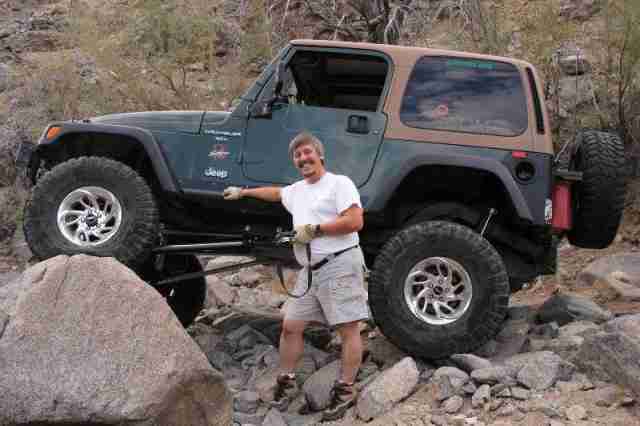
Same rock as the above pic….yes, it was a climb to get the tire up on it….I had to turn on the front ARB! The low spot (I am standing in it) made it interesting, especially when I decided to climb back in!
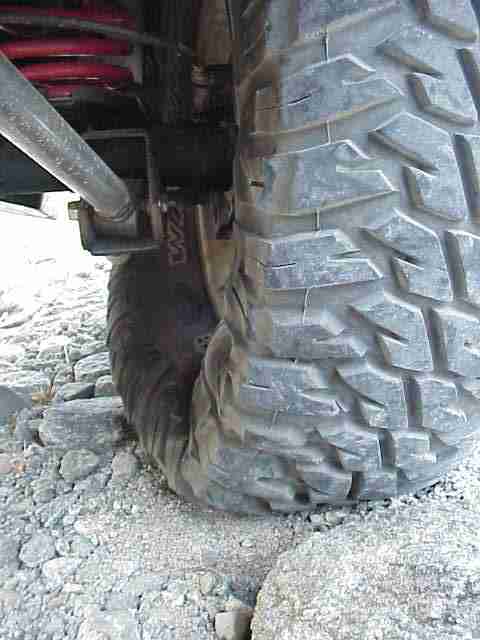
OK, so this isn’t really a suspension shot, but it had been a while since I had seen that much of a fold in my MT/Rs sidewall.

It was about here that I decided I need to loosen up the Currie Anti-rock front sway bar. I talked to a mechanical engineering friend of mine (who also happens to be a good Jeepin’ buddy), and ran a couple of questions past him. He told me that it was OK to run the Currie links in different positions (on each of the arms). I need to do some checking but I think I have room to put the driver’s side link in the softest position. Doing so will loosen up the front axle a bit and allow the axle to droop better. The fact that I was climbing didn’t help a bit….the weight transfer to the rear allows the front end to unload and spring compression is greatly reduced.

We made it to the end of Upper Tax Collector just as the sun was burning through the morning cloud cover. Perfect timing….things were starting to warm up for a typical July day in Phoenix. I raided the cooler one more time for a bottle of ice cold water. We headed back to the air up spot, said our goodbyes, and headed for home.
Note: Here are a few pictures taken on 11/22/03 after we got off of the Upper Woodpecker trail. We were discussing springs and flex and I parked mine on a rock to so we could see how close to the bump stops I was. Basically, I don’t have enough weight to fully compress the springs. Warning, these are approximately 1 MB in size (high res camera and not reduced in size.)
Alumiflex-1 – front spring is about 3″ unseated
Alumiflex-2 – other side, same pose
Alumiflex-3 – yes, the Antirock does twist….you would be hard pressed to say it is limiting my flex (the other arm is sitting in the middle hole.
Alumiflex-4 – same view, just moved back a bit
Alumiflex-5 – gotta love the ways those sidewall flex (driver’s side rear)
And a few more pics taken on various trails during the months following the new lift install. As you can see, the springs are becoming much more compliant and my flex is getting to where I would expect it to be. A friend had told me it would take the better part of 6 months to get the Skyjacker springs to work well…..and he was right on the money.
Alumiflex-6 – first we twist it one way
Alumiflex-7 – then we twist it the other way
Alumiflex-8 – after about 5 months, the springs are compressing much better, but no change in static height (no spring sag)
Alumiflex-9 – same pic as the one above, just moved back a bit
